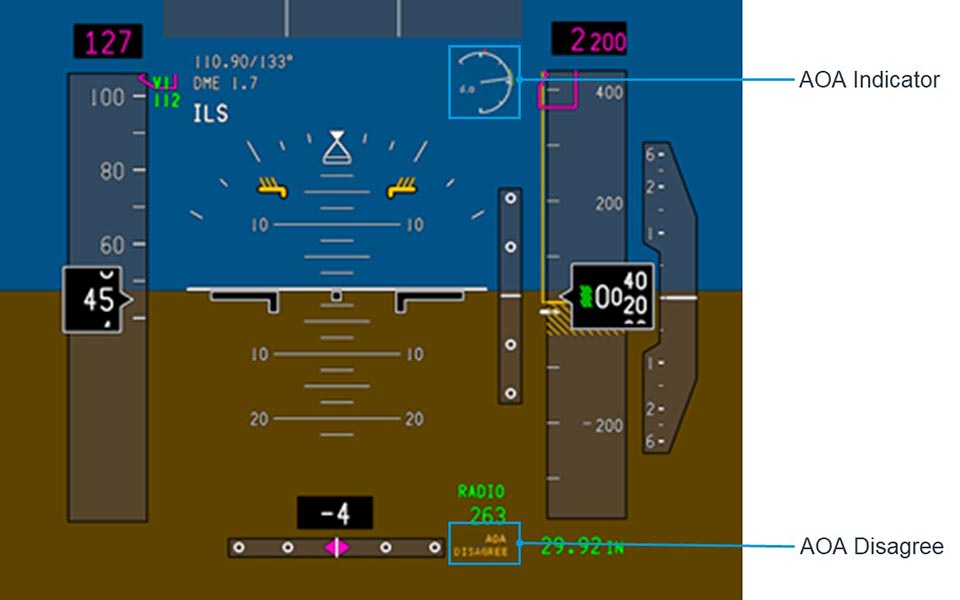From Bjorn Fehrm of Leeham today:
This week Boeing presented how they plan to get the 737 MAX back in the air again. MCAS has a fix.We look at what the fix tells us about the first implementation and the rationale behind its implementation.

Figure 1. The improved Pilotís Primary Flight Display presented Wednesday. Source: Boeing.
Boeingís MCAS fix casts light on the original implementation
Boeing presented its fix for the MCAS problems Wednesday. By it, it spotlights what was wrong with the original implementation.
The reliance on a single triggering signal for MCAS
A lot has been written about the MCAS system relying on a single Angle of Attack input. This is unusual for systems involved in the flight control of aircraft. Normally you have three inputs so a voting procedure can sort out one of them if it has a problem (two singling out the third as faulty).
The 737 has only two Angle of Attack sensors, so no voting can be set up between them. Instead, the system relying on the sensors can be switched off if the sensors disagree and the pilot informed about the missing function.
This is the route chosen for the improved MCAS. It will now be disconnected when the sensed Angle of Attack difference is beyond 5.5 degrees when MCAS activates and over 10 degrees for over 10s when the system is in use.
The wide allowed difference shows what I have written about before. The aerodynamics around these sensor vanes, placed at the nose sides, is dependent on how the aircraft is flown. If there is a sideslip the airflow passing the sensors will be affected and the sensor values will differ.
The actual sensor value is also higher than the wing Angle of Attack (the airflow around a fuselage nose is curving upward), therefore a correction table is used to calculate the wingís Angle of Attack. Itís the wingís Angle of Attack which determines how close to stall the aircraft is.
Was the use of only one signal OK to trigger the original MCAS? No, it wasnít. But at least there was a rationale for this decision, whatever one might think about the rationale. A deactivation of MCAS was not an acceptable solution as it would trigger a need for an MCAS not available signal and this would mean more difference training for the Pilots migrating from 737ng to MAX.
The design of the original MCAS function
While the reliance on a single sensor is highly questionable, the architecture and implementation of the original MCAS function in inexcusable.
If you have a flight control function which is triggered by a single sensor, it means the likelihood it being incorrectly activated is there.
Then you implement a nonhazardous augmentation function!
You make sure it only injects the minimum correction necessary and you limit its total authority to not jeopardize the safe flight of the aircraft.
Where others focus on a single trigger signal, my biggest problem is with the function itself. If you have a weak trigger architecture, you limit the authority of what you trigger!
There was no need for the authority MCAS got. We know this today as the software fix only trims once for each elevated Angle of Attack event and limits the total trim amount to a safe level. This is regardless of the sensors being wrong or the function running wild.
It was just a very, very bad function design, and there was no need for it.
Designed to not show, it became the centerpiece of attention
MCAS was a function put there to cater for a very remote case. The pilot needs to maneuver close to the limits of the aircraft and way beyond normal flying practice, to save the aircraft from some emergency. Then MCAS kicked in to make the aircraft easy to fly close to its limits.
In the life of a commercial 737 MAX pilot he should never experience an MCAS augmentation, its use case was so remote. Instead, it became the most known and explained function of all on the 737 MAX. And for the wrong, very sad reasons.
There are only a few airliner OEMs in the world. There is a reason for this. Itís a challenging product to get right and the stakes are very high for any mistakes. In todayís very safe air transport system mistakes of this scale are non-acceptable.